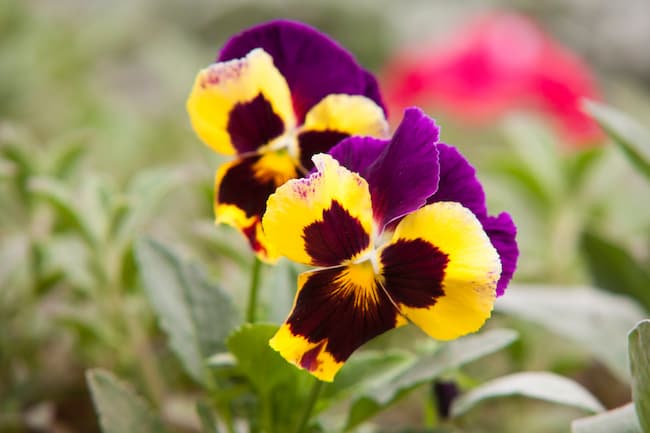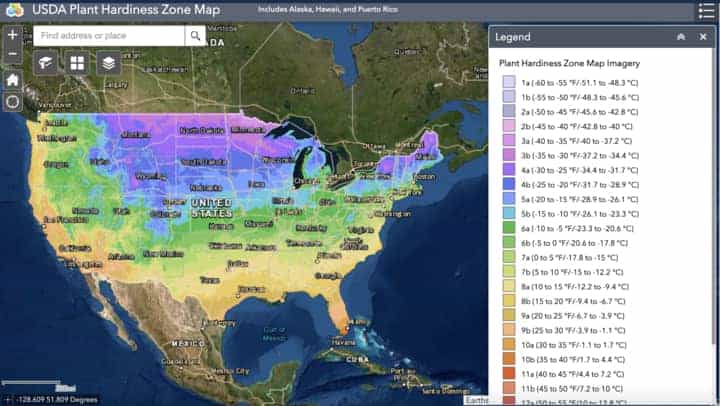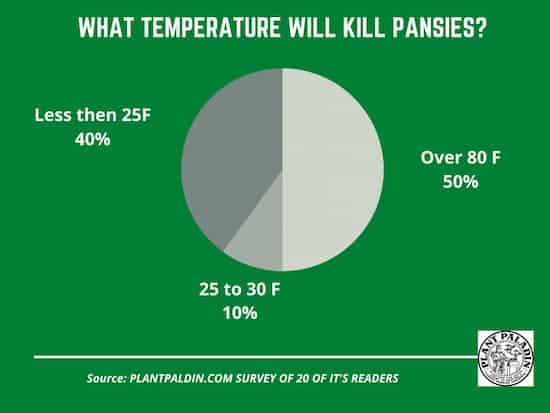This website is supported by its readers. If you click one of my links I may earn a commission. I am also a participant in the Amazon affiliates program and I will also earn a commission from qualified purchases.

So recently, I popped over to my local garden center to pick up some winter supplies for my bonsai tree collection. That said, they had an offer on for pansies. I thought, hey-ho, why not pick them up? Having not grown this flower before, I wondered what temperature would kill pansies.
Pansies will deteriorate and die at temperatures colder than 25 degrees Fahrenheit (-3 degrees Celcius). Pansies will also die should temperatures become too hot. Should temperatures exceed 80 degrees Fahrenheit (26 degrees Celsius) for several days consecutively, this will kill your pansy too.
So, what are the best ways to care for your pansies in the summer and winter? And what is the exact science behind these temperatures for pansies? Keep reading to find out more.
Just a quick heads up, over the past three years of running Plantpaladin, hundreds of people have asked for product recommendations. As such, You can find my favorite indoor bonsai tree here (link takes you to Bonsaiboy), my favorite outdoor bonsai tree (link takes you to Bonsaiboy), or have a look at all the products I recommend here.
What temperature will kill pansies?
Now, having only really started to add to the flower collection in my backyard, I want to ensure that all the information in this post is as accurate as possible,
As such, I contacted my local gardener and botanical gardens and even surveyed 20 PlantPaladin readers who own pansies, asking them what temperature will kill them.
On top of this, I also read up on as many studies and scientific literature as possible. All to ensure this post was as in-depth as possible.
To summarise:
- The coldest temperature that pansies can survive is 25 degrees Fahrenheit or -3 degrees Celcius.
- Pansies then are pretty hardy, surviving in cold conditions for significant periods. These flowers will perform best in temperatures between 40 and 60 degrees F, making them ideal fall, winter, and early spring flowers.
- When temperatures drop below 25 degrees F for too long (aka several days consistently), it can cause the roots to become less effective, stopping the roots from absorbing water and resulting in the plant’s flowers and leaves shrinking.
- The giant killer when it comes to low temperatures to pansies, however, will be frost damage.
- Excessive frost will again cause the roots of your pansies to freeze, stopping them from absorbing vital nutrients and water from the soil.
- The warmest temperature pansies can survive is about 80 degrees F or 26 degrees Celsius.
- Pansies are much more adept at dealing with cooler temperatures than warmer ones.
- Should temperatures exceed 80 degrees F consistently for a few days, this will cause the leaves to start to burn and wilt and stop the flowers from blooming.
This is a lot of information, so let’s break this down, starting with cold temperatures.

Can pansies survive cold winter?
One of the significant benefits of pansies is that, unlike many other flowering plants, they are very cold-resistant.
These trees then love growing in cool to mild conditions.
That said, if you live in a temperate climate like I do, winter conditions can drop very low every few years, so can pansies survive cold winters.
Pansies are adept at surviving cold winters. Most pansies will thrive in temperatures up to 25 degrees F ( -3 degrees C) for a few days.
Should temperatures drop below this, they can still do well in relatively cold single-digit temperatures so long as you can successfully manage the cold.
With pansies, low temperatures are not necessarily the wrong thing; it is mainly the frost.
Can pansies survive frost?
So, as mentioned above, the one thing you must be careful of when keeping your pansies outside during cold temperatures is the frost.
Pansies cannot survive frost and frost damage. This is because the frost will cause your pansy’s cells to rupture, causing them to die. Pansies, then, should be protected from both ground and air frosts.
While the cold can slow down how effective your pansies are at absorbing nutrients and photosynthesizing, frost is the secret killer of pansies.
Now, frost damage is not unique to pansies but to most flower plants.
The primary damage that frost causes is that the freezing water causes a plant’s cells to get ripped apart.
Think of it as how potholes form but instead in a much more brutal way for your flowers.
As such, prolonged exposure to cold frosts will cause the following problems:
- Black scorching and brown leaf patches
- Wilted and water-soaked growth.
- Damage to flowers
- Dry, brittle leaves and branches.
What types of frost will impact pansies
Now, not all frosts are created equal.
In reality, there are two main types of frosts that you need to be aware of for your pansies in winter:
- Air frost.
- Ground frost.
Air frost occurs when the air surrounding your pansies drops below freezing (0C, 32F). This will cause a light dusting of ice to grow on your tree’s branches and leaves.
Ground frost occurs when temperatures drop below freezing in the soil and ground your pansies are growing in.
While air frosts can be damaging, in reality, during the day, any first damage is usually negated by the sun.
In reality, ground frost is the type of frost you need to be most worried about and will impact your pansies the most.
We will go into more detail on protecting your pansies from frost. However, there are a few quick things you need to note;
- Pansies grown in pots are more susceptible to ground frost than pansies grown in the ground.
- Younger pansies will be more susceptible to damage.
- The most significant factor impacting frost damage will be time exposure.
Should your pansies be exposed to frost regularly, this will be the most significant cause of concern.
How to protect your pansies from frost damage in winter?
So what are some tips you can follow to prevent you from having any frost and cold mishaps this winter?
Choose cold-tolerant pansy varieties.
Start by selecting pansy varieties that are more resistant to cold temperatures. Some pansies are bred to withstand colder weather better than others, so check with your local nursery or garden center for recommendations.
Plant at the right time
Plant pansies in the late summer or early fall to allow them to establish themselves before winter. This gives the roots time to grow and helps the plants become more resilient to frost.
Mulch around the plants
Apply a layer of organic mulch around your pansies, such as straw, pine needles, or shredded leaves. Mulch helps to insulate the soil, regulate temperature, and protect the roots from freezing.
Make sure not to pile mulch directly against the plant stems.
Mulching is a topic, so I’ll cover it later in the post.
Water properly
Keep the soil consistently moist but not soggy. Well-hydrated plants are less likely to succumb to frost damage.
Water in the morning so that the soil can dry before nighttime when frost is more likely.
Use frost cloth or blankets.
When a frost or freeze is expected, cover your pansies with frost cloth or old blankets in the evening before temperatures drop.
Secure the coverings with stakes or rocks to prevent them from blowing away. Remove the coverings during the day to allow sunlight and air circulation.
Provide additional heat
Consider using frost protection devices like frost pots, heat lamps, or even Christmas lights (not LED) to provide extra warmth to your pansies.
Place these devices close to the plants, but ensure they are not touching them to avoid damage.
Bring containers indoors
If you have potted pansies, move the containers indoors or into a sheltered area like a garage or shed during freezing nights. This will protect them from the cold and frost.
Smaller pansies grown in posts are much more susceptible to cold temperatures, so doing so will ensure your pansies stay safe.
Prune damaged leaves
After a frost event, check your pansies for any damaged or wilted leaves.
Prune these leaves away to encourage new growth and prevent disease.
Deadheading your flowers, too, can be a surefire way of preventing your flowers from dying off and not blooming in future seasons.
Be prepared for unexpected frosts.
Keep an eye on weather forecasts, especially during transitional seasons when frost is more likely to occur. Be ready to cover your pansies or take other protective measures when frost is expected.
Will freezing temperatures kill pansies?
Temperatures at freezing point (0 degrees Celcius, 32 degrees Fahrenheit) will not kill your pansies over short periods. Instead, the frost damage at prolonged periods below these temperatures will kill your flowers.
As such, ensure you use the steps above to prevent any frost damage from building up in your pansies.
Is mulching important for pansies during winter?
Now, from interviewing and surveying a few experts, without a doubt, the most significant protection you can give to your pansies during winter is mulching them.
You see, mulching and applying a layer of about 2 to 3 inches of organic or fabric material over your pansies’ topsoil will protect the soil from ground and air frost.
This will ensure that the soil is a few degrees warmer than its surrounding areas, ensuring that the roots can still absorb nutrients from its soil even if frost is present.
Use a mix of pine straw mulch, a fantastic natural insulator, for best results.
This type of mulch is relatively lightweight, too, meaning you won’t have to worry about fungal or mold build-ups in your solid or plant.
What type of pansies are best suited to the cold
As mentioned above, one of the easiest ways to get around cold damage is to choose a pansy species best suited to the cold.
That said, with over 600 sub-species of pansies, it’s much easier said than done.
So what are ten of the best pansies species at dealing with cold conditions:
Winter pansies, clear crystal pansies, and majestic giant pansies are amongst the best pansies species to keep during winter. These plants will be able to survive very cold temperatures and have some resistance to frost damage in short periods.
I’ve put these pansies in a table below, which should help shed some light on their resistance to cold.
Pansy Variety | Cold Tolerance Rating (out of 10) |
Winter Pansy | 9 |
Delta® Pansies | 8 |
Matrix® Pansies | 8 |
Ice Pansy | 9 |
Clear Crystals Pansies | 7 |
Frizzle Sizzle Pansies | 8 |
Inspire Plus® Pansies | 8 |
Majestic Giant Pansies | 7 |
Cool Wave® Pansies | 9 |
Viola cornuta | 10 |
How hot is too hot for pansies
So, on the other end of the spectrum, it’s crucial to consider how hot temperatures impact pansies.
Surprisingly, pansies are cold-resistant, but the same cannot be said for warmer temperatures.
Pansies prefer much milder temperatures, and so during the spring and summer months, should temperatures exceed 80 degrees F ( 26 degrees Fahrenheit) for a few days, your tree will become dehydrated, start to burn, and develop crusty dry flowers.
Left unchecked, this will kill your pansies.
Now, pansies do not like the warm, so aim to keep your pansy in temperatures below 80 degrees in 24 hours.
If temperatures exceed 90 degrees during the day but 70 degrees at night, then your pansies may get an average of around 80 degrees of heat through 24 hours.
You must move your pansies indoors if temperatures stay 90 degrees for 24 hours.
Pansies and heat damage
So, similarly to frost damage, heat damage also attacks all mild flowers like pansies.
The main symptoms of heat damage then will be dropping lifeless leaves, stems, and branches, Flowers that do not bloom and burned edges on the leaves of your pansies are also common signs of heat damage.,
Probably the most significant impact, however, of heat damage is dehydration,
Pansies need water to transport nutrients around and photosynthesize effectively.
When temperatures are too hot, this will cause your pansies not to have enough water to do their job, essentially dehydrating and killing your tree.
How to protect your pansies from high temperatures
So now we know that too much heat is bad for your pansies, what are some quick tips that you can implement to protect your pansies in the summer:
Water Properly
Water your pansies early in the morning when the temperatures are cooler. This allows the soil to absorb moisture before the heat of the day. Avoid watering in the evening, as damp foliage overnight can lead to fungal issues.
Use a soaker hose, drip irrigation, or a watering can with a spout that directs water at the base of the plants. Watering the soil directly around the roots is more efficient and reduces the risk of fungal diseases.
Mulch
Apply a 2-3 inch layer of organic mulch, such as straw, wood chips, or shredded leaves, around the base of your pansies. Mulch helps keep the soil cooler by reducing evaporation and insulating the roots.
Be careful not to pile mulch directly against the plant stems, as this can create a moist environment that promotes rot.
Shade
When heatwaves are forecasted, consider providing temporary shade during the hottest part of the day.
You can use shade cloth, plant taller heat-tolerant plants nearby to cast shade or move potted pansies to a shadier location.
Fertilize Sparingly
Choose a balanced, slow-release fertilizer if you need to fertilize your pansies during hot weather. Follow the recommended application rates on the fertilizer packaging, and avoid overfeeding, as excessive nutrients can stress the plants.
Deadhead Regularly
Remove spent flowers by pinching or cutting them off regularly. Deadheading encourages the plant to put energy into new flower production rather than seed production, which can help reduce stress during heat.
Prune Leggy Growth
If your pansies become leggy and stretched out due to heat stress, use clean scissors or pruning shears to trim back the leggy growth. This promotes a bushier, more compact shape.
Plant Heat-Tolerant Varieties
When choosing pansy varieties, consider those labeled as heat-tolerant or suitable for warmer climates. These varieties are better equipped to handle high temperatures.
Monitor Soil Temperature
Use a soil thermometer to check the soil temperature around your pansies. If it becomes sweltering, add more mulch to insulate the soil or use shade to cool the area.
Water Trays
Placing water trays near your pansies can create a microclimate with higher humidity. As the water evaporates, it cools the surrounding air, providing some relief from the heat.
Regular Inspection
Keep a close eye on your pansies during hot spells. Look for signs of wilting, yellowing leaves, or other stress indicators. Promptly address any issues by adjusting watering, shading, or pruning.
What pansy species prefer warm temperatures
So, while most pansies prefer cold temperatures, there are a few species that will do okay during warmer springs and summers:
Clear Mix Pansies, Colossus Pansies, and Fama Pansies are larger, more robust, and more heat and temperature-resistant than other pansy varieties.
What is the perfect temperature for pansies?
So now we know that extreme cold and warmth will be too much for pansies; what exactly is their ideal temperature range?
The best temperature range to keep pansies at will be between 40 and 60 degrees Fahrenheit or 4 to 15 degrees Celsius. You can expect your pansies to grow in their healthier, most vigorous conditions at these temperatures.
If you use the USDA hardiness zones, pansies will grow in zones 9a to 12b without any protection.
In zones lower than 9a, I suggest mulching or moving your pansies indoors.
Consider planting your pansies in the shade in zones over 12b during the summer or moving to a cooler temperature.

Are pansies okay in 40-degree weather?
Pansies thrive in temperatures around 40 degrees Fahrenheit (4 degrees Celsius). These flowers are incredibly hardy, meaning that while this temperature may be too low for some flowers, pansies will have no trouble growing successfully in these low temperatures.
Are pansies okay in 30-degree weather?
Pansies will grow perfectly fine in temperatures around 30 degrees Fahrenheit (-1 degrees C). Pansies are very hardy plants, making them ideal for low-temperature growing. The only caveat to this is to keep an eye out for prolonged frost, which can damage pansies.
How long do pansies last?
Today’s post has helped show how long pansies can last for different temperature requirements.
To summarise once again:
- The ideal temperature range for pansies is 40 to 60 degrees F
- If grown at these temperatures, you can expect pansies to live for three or more years, producing flowers once per year/bi-annually.
- Pansies can tolerate the cold well and survive temperatures lower than 25 degrees for a few days.
- However, ensure that frost care is taken at low temperatures to prevent any long-term damage.
- Avoid keeping your pansies in temperatures over 8- degrees F for prolonged periods.
- If so, your pansies will start to dehydrate and die from the lack of water.
Pansies and temperature – what the science says
Now, it’s essential that I not only use my sources of information but also share some of the latest scientific literature on what temperature will kill pansies.
To summarise:
- Utah State (2014) – Pansies will grow and survive longer in cold conditions where frost is absent.
- Wade et al. (University of Georgia) – Pansies can bounce back after a short winter /frost damage.
- Kwon (1992) – 40 to 60 degrees is the ideal temperature range for pansies.
What temperature will kill pansies – Survey results
Finally, I surveyed 20 plant paladin readers, asking them what temperature would kill pansies.
Here are the results

My top picks for the gear you will need!
So like I mentioned earlier, over the past three years of running PlantPaladin, hundreds of people have asked me for my recommendations on the best bonsai gear on the market.
Having spent thousands of dollars on bonsai items these past few years and tested at least 100 bonsai-specific products, I’ve listed my favorite products below – All of which I highly recommend and think you can get great value.
They can purchase directly by clicking the link to take them to Amazon.
Bonsai Tool Set: One of the significant challenges I’ve had is finding a toolset that was not only durable but didn’t break the bank. SOLIGT has recently developed a fantastic bonsai tool set that covers all the tools you need to trim, prune, and repot your trees. – You can grab it here.
Complete Bonsai Set: Many of you will want to grow your bonsai trees entirely from scratch, but finding the varicose seeds, pots, and other items in one place can be challenging. Leaves and Sole then have created a complete bonsai set that I’ve personally used that ticks all the boxes. You can grab it here.
Bonsai wire: The number of times I’ve run out of wire for my bonsai or purchased cheap bonsai wire that doesn’t do the job is embarrassing for me to admit. After a lot of trial and error, I found that using Hotop’s aluminum bonsai wire is one of the best options on the market. This can easily be used for both indoor and outdoor bonsai. You can grab it here.
